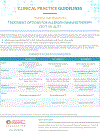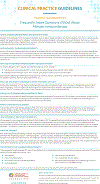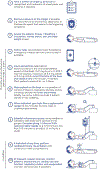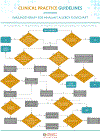Clinical Practice Guideline: Immunotherapy for Inhalant Allergy
- PMID: 38408152
- PMCID: PMC11788925
- DOI: 10.1002/ohn.648
Clinical Practice Guideline: Immunotherapy for Inhalant Allergy
Abstract
Objective: Allergen immunotherapy (AIT) is the therapeutic exposure to an allergen or allergens selected by clinical assessment and allergy testing to decrease allergic symptoms and induce immunologic tolerance. Inhalant AIT is administered to millions of patients for allergic rhinitis (AR) and allergic asthma (AA) and is most commonly delivered as subcutaneous immunotherapy (SCIT) or sublingual immunotherapy (SLIT). Despite its widespread use, there is variability in the initiation and delivery of safe and effective immunotherapy, and there are opportunities for evidence-based recommendations for improved patient care.
Purpose: The purpose of this clinical practice guideline (CPG) is to identify quality improvement opportunities and provide clinicians trustworthy, evidence-based recommendations regarding the management of inhaled allergies with immunotherapy. Specific goals of the guideline are to optimize patient care, promote safe and effective therapy, reduce unjustified variations in care, and reduce the risk of harm. The target patients for the guideline are any individuals aged 5 years and older with AR, with or without AA, who are either candidates for immunotherapy or treated with immunotherapy for their inhalant allergies. The target audience is all clinicians involved in the administration of immunotherapy. This guideline is intended to focus on evidence-based quality improvement opportunities judged most important by the guideline development group (GDG). It is not intended to be a comprehensive, general guide regarding the management of inhaled allergies with immunotherapy. The statements in this guideline are not intended to limit or restrict care provided by clinicians based on their experience and assessment of individual patients.
Action statements: The GDG made a strong recommendation that (Key Action Statement [KAS] 10) the clinician performing allergy skin testing or administering AIT must be able to diagnose and manage anaphylaxis. The GDG made recommendations for the following KASs: (KAS 1) Clinicians should offer or refer to a clinician who can offer immunotherapy for patients with AR with or without AA if their patients' symptoms are inadequately controlled with medical therapy, allergen avoidance, or both, or have a preference for immunomodulation. (KAS 2A) Clinicians should not initiate AIT for patients who are pregnant, have uncontrolled asthma, or are unable to tolerate injectable epinephrine. (KAS 3) Clinicians should evaluate the patient or refer the patient to a clinician who can evaluate for signs and symptoms of asthma before initiating AIT and for signs and symptoms of uncontrolled asthma before administering subsequent AIT. (KAS 4) Clinicians should educate patients who are immunotherapy candidates regarding the differences between SCIT and SLIT (aqueous and tablet) including risks, benefits, convenience, and costs. (KAS 5) Clinicians should educate patients about the potential benefits of AIT in (1) preventing new allergen sensitizations, (2) reducing the risk of developing AA, and (3) altering the natural history of the disease with continued benefit after discontinuation of therapy. (KAS 6) Clinicians who administer SLIT to patients with seasonal AR should offer pre- and co-seasonal immunotherapy. (KAS 7) Clinicians prescribing AIT should limit treatment to only those clinically relevant allergens that correlate with the patient's history and are confirmed by testing. (KAS 9) Clinicians administering AIT should continue escalation or maintenance dosing when patients have local reactions (LRs) to AIT. (KAS 11) Clinicians should avoid repeat allergy testing as an assessment of the efficacy of ongoing AIT unless there is a change in environmental exposures or a loss of control of symptoms. (KAS 12) For patients who are experiencing symptomatic control from AIT, clinicians should treat for a minimum duration of 3 years, with ongoing treatment duration based on patient response to treatment. The GDG offered the following KASs as options: (KAS 2B) Clinicians may choose not to initiate AIT for patients who use concomitant beta-blockers, have a history of anaphylaxis, have systemic immunosuppression, or have eosinophilic esophagitis (SLIT only). (KAS 8) Clinicians may treat polysensitized patients with a limited number of allergens.
Keywords: allergen immunotherapy; allergic asthma; allergic rhinitis; anaphylaxis; inhalant allergy; subcutaneous immunotherapy; sublingual immunotherapy.
© 2024 American Academy of Otolaryngology-Head and Neck Surgery Foundation.
Conflict of interest statement
The cost of developing this guideline was covered in full by the AAO‐HNSF. Potential conflicts of interest for all panel members in the past 2 years were compiled and distributed before the first conference call. After review and discussion of these disclosures, the GDG concluded that individuals with potential conflicts could remain on the panel if they: (1) reminded the panel of potential conflicts before any related discussion, (2) recused themselves from a related discussion if asked by the panel, and (3) agreed not to discuss any aspect of the guideline with industry before publication. Finally, panelists were reminded that conflicts of interest extend beyond financial relationships and may include personal experiences, how a participant earns a living, and the participant’s previously established “stake” in an issue. Conflicts were again delineated at the start of the meeting and at the start of each teleconference meeting, with the same caveats followed. All conflicts are disclosed at the end of this document.
Figures






References
-
- Pfaar O, Bachert C, Bufe A, et al. Guideline on allergen‐specific immunotherapy in IgE‐mediated allergic diseases: S2k Guideline of the German Society for Allergology and Clinical Immunology (DGAKI), the Society for Pediatric Allergy and Environmental Medicine (GPA), the Medical Association of German Allergologists (AeDA), the Austrian Society for Allergy and Immunology (ÖGAI), the Swiss Society for Allergy and Immunology (SGAI), the German Society of Dermatology (DDG), the German Society of Oto‐Rhino‐Laryngology, Head and Neck Surgery (DGHNO‐KHC), the German Society of Pediatrics and Adolescent Medicine (DGKJ), the Society for Pediatric Pneumology (GPP), the German Respiratory Society (DGP), the German Association of ENT Surgeons (BV‐HNO), the Professional Federation of Paediatricians and Youth Doctors (BVKJ), the Federal Association of Pulmonologists (BDP) and the German Dermatologists Association (BVDD). Allergo J Int 2014;23(8):282–319. - PMC - PubMed
-
- Seidman MD, Gurgel RK, Lin SY, et al. Clinical practice guideline: allergic rhinitis. Otolaryngol Head Neck Surg 2015;152(1 suppl):S1–S43. - PubMed
-
- Cox L, Nelson H, Lockey R, et al. Allergen immunotherapy: a practice parameter third update. J Allergy Clin Immunol 2011;127(1 suppl):S1–S55. - PubMed
-
- Pitsios C, Demoly P, Bilò MB, et al. Clinical contraindications to allergen immunotherapy: an EAACI position paper. Allergy 2015;70(8):897–909. - PubMed
Publication types
MeSH terms
Substances
Grants and funding
LinkOut - more resources
Full Text Sources
Medical
Research Materials

